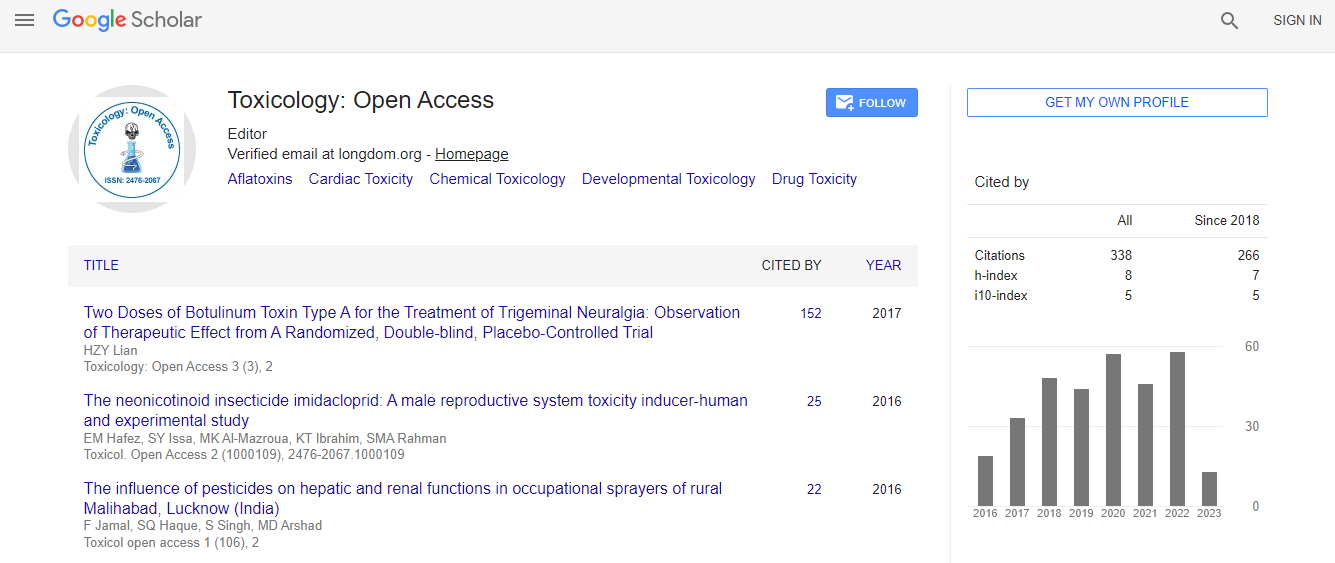Our Group organises 3000+ Global Conferenceseries Events every year across USA, Europe & Asia with support from 1000 more scientific Societies and Publishes 700+ Open Access Journals which contains over 50000 eminent personalities, reputed scientists as editorial board members.
Open Access Journals gaining more Readers and Citations
700 Journals and 15,000,000 Readers Each Journal is getting 25,000+ Readers
Google Scholar citation report
Citations : 336
Toxicology: Open Access received 336 citations as per Google Scholar report
Indexed In
- Google Scholar
- RefSeek
- Hamdard University
- EBSCO A-Z
- Geneva Foundation for Medical Education and Research
- Euro Pub
- ICMJE
Useful Links
Related Subjects
Share This Page
Effect of honey on rate of healing of socket after tooth extraction in rabbits
14th World Congress on Toxicology and Pharmacology
Deependra Prasad Sarraf, Jaisani Mehul Rajesh, Shrestha Ashish and Rauniar Gajendra Prasad
B.P. Koirala Institute of Health Sciences, Nepal
Posters & Accepted Abstracts: Toxicol Open Access
Abstract
Statement of the Problem: Honey is the worlds��? oldest known wound dressing. Its wound healing properties is not fully established till today. Concerns about antibiotic resistance and a renewed interest in natural remedies, have prompted resurgence in the antimicrobial and wound healing properties of honey. Evidence from animal studies and some trials has suggested that honey may accelerate wound healing in burns, infected wounds and open wounds. None of these reports have documented the effect of honey on healing of socket after tooth extraction. Therefore, the present experimental study was planned to evaluate the efficacy of honey on the healing of socket after tooth extraction in rabbits. Methodology & Theoretical Orientation: An experimental study was conducted in six New Zealand white rabbits. Extraction of first premolar tooth on both sides of lower jaw was done under anesthesia produced by ketamine and xylazine followed by application of honey on one socket (test group) and normal saline (control group) in the opposite socket. The intervention was continued for two more days. On 7th day, biopsy was taken from the extraction site and histo-pathological examination was done. Student��?s t-test was used for comparison between the groups and differences were considered to be statistically significant at p value less than 0.05. Findings: There was a significant difference between control group and test group in terms of fibroblast proliferation (p=0.0019) and bony trabeculae formation (p=0.0003). Inflammatory cells were also observed in both groups and it was not significant (p=1.0). Overlying epithelium was hyperplastic in both the groups. Conclusion & Significance: The study showed that local application of honey promoted the rapid healing process particularly by increasing fibroblast proliferation and bony trabeculae. Recent Publications 1. DP Sarraf, GP Rauniar, H Sangraula (2013) Effect of Ocimum gratissimum in rodents. Health Renaissance; 11(3): 198-204. 2. A Misra, DP Sarraf, GP Rauniar (2013) Prescribing Pattern of Antimicrobials in the In-Patients Department of Obstetrics and Gynaecology at A Tertiary Care Teaching Hospital at Nepal. International Journal of Pharmaceutical & Biological Archives; 4(5): 893��?898.Biography
Deependra Prasad Sarraf has his expertise in in vivo studies of natural herbs and medicinal foods. He is also involved in undergraduate and postgraduate medical students’ teaching, thesis guidance and mentoring.
Email:deependraprasadsarraf@gmail.com

 Spanish
Spanish  Chinese
Chinese  Russian
Russian  German
German  French
French  Japanese
Japanese  Portuguese
Portuguese  Hindi
Hindi 